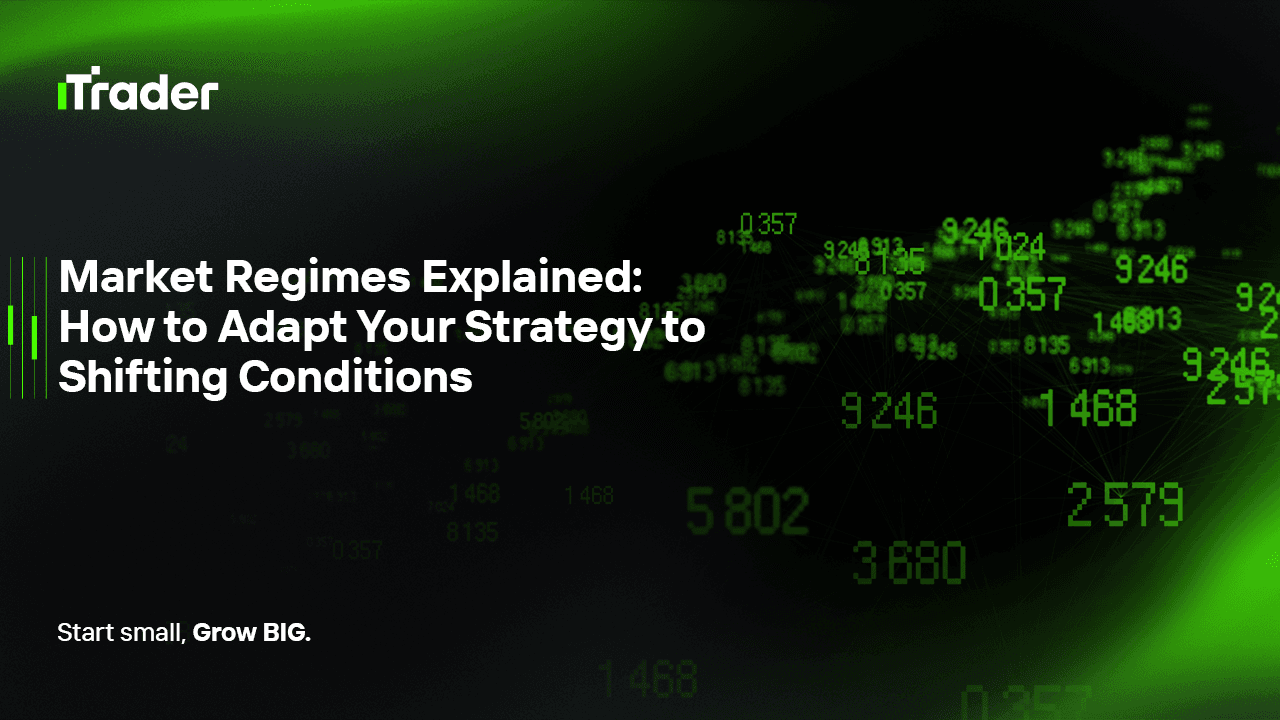2025-09-29
In the Forex market, stable and predictable environments are rare. Exchange rates can fluctuate sharply over short periods, while at other times, they may stagnate without any clear direction. In some phases, macroeconomic factors dominate price action; in others, technical dynamics take the lead. All of this directly affects the performance of trading strategies: what works well in one environment may underperform or even fail in another.

For prop traders, understanding market regimes and adjusting strategies accordingly is not merely a question of profit maximization. It’s a critical factor in passing evaluations, managing drawdowns, and securing funding.
This blog explores what market regimes are, how to identify them, how to adjust strategies when conditions shift, and why this adaptive ability is essential in a prop trading environment.
A market regime refers to the dominant structural and behavioral characteristics of the market over a specific period. Each trading strategy tends to perform best under a particular set of conditions. When the regime changes, performance deterioration is common if the strategy is not adapted accordingly.
Market regimes can be categorized in various ways, but the most common classifications are based on four main dimensions:
Identifying the prevailing regime provides the foundation for deciding which strategies to deploy, how to size positions, and when to stand aside.
Market regimes should not be identified by intuition alone. Using objective metrics allows traders to systematically classify conditions and adjust accordingly. The following are commonly used tools.
Rising volatility often calls for smaller position sizing or wider stop placement to avoid unnecessary whipsaws.
Most strategies are overfitted to a particular environment during backtesting. Parameter settings that work well in one regime often break down when conditions shift. This leads to several common issues:
When regimes shift, traders should not blindly abandon their systems. Instead, they should apply structured adaptation methods, including rule-based adjustments, volatility-sensitive sizing, filtering, or switching between strategy clusters.
This involves setting clear, objective rules for determining the current regime and activating specific strategies accordingly. For example:
This approach provides a systematic way to align strategies with prevailing conditions.
Adjusting position size according to volatility is one of the most effective ways to control drawdowns. By linking position size to ATR or historical volatility, traders can reduce risk during turbulent periods and scale up during stable phases.
This involves running multiple strategies in parallel and dynamically allocating capital based on regime. For example:
More advanced methods include:
These approaches enable a higher degree of automation in adapting strategies to changing environments.
Theory alone is not enough. To benefit from regime analysis, traders must integrate it into their daily and systematic processes.
Keep a daily log that maps observed market regimes to strategy performance. Over time, this creates a clear picture of which strategies work best in which conditions. It also improves your situational awareness as a trader.
Instead of relying on static backtests, use Walk-Forward Analysis to periodically re-optimize strategy parameters on rolling windows. This reduces overfitting and maintains alignment with current market regimes.
Monitor regime indicators in real time and adjust position sizing, entry filters, or strategy activation accordingly. For prop traders, this is essential to staying within daily and overall drawdown limits.
Prop firms evaluate traders primarily on consistency and risk control. Many traders fail evaluations not because their strategies are bad, but because they don’t adapt when market conditions change.
A trader with strong regime adaptation capabilities can:
In short, regime adaptation transforms a trader from someone who merely “has a good strategy” into someone who can survive, adapt, and thrive in any market.
Market regimes represent the underlying structure of price behavior. Ignoring them and applying a fixed strategy mechanically leads to performance decay, drawdowns, and potential funding failures.
Traders who use objective regime identification metrics and implement systematic adjustments—through rule-based switching, volatility-sensitive sizing, strategy stacking, or machine learning—gain a critical advantage. They:
Strategy ≠ Success.
Strategy × Market Regime Alignment = Sustainable Performance.
© 2025 iTrader Global Limited|公司註冊編號:15962
iTrader Global Limited 註冊於科摩羅聯盟昂儒昂自治島穆扎穆杜 Hamchako,並受科摩羅證券委員會授權與監管。我們的牌照編號為 L15962/ITGL。
iTrader Global Limited 以「iTrader」為商業名稱經營,獲得從事外匯交易活動之授權。公司標誌、商標與網站均為 iTrader Global Limited 之專有財產。
iTrader Global Limited 的其他子公司包括:iTrader Global Pty Ltd,澳洲公司註冊編號(ACN):686 857 198。該公司是 Opheleo Holdings Pty Ltd 的授權代表(澳洲金融服務代表編號:001315037),Opheleo 持有澳洲金融服務執照(AFSL 編號:000224485),註冊地址為:Level 1, 256 Rundle St, Adelaide, SA 5000。
免責聲明:本實體並非本網站所交易金融產品之發行者,亦不對其負責。
風險提示: 差價合約(CFD)交易因槓桿效應具高度資本迅速損失風險,未必適合所有使用者。
參與基金、差價合約及其他高槓桿商品交易,需具備專業知識。
研究顯示,84.01% 的槓桿交易者最終蒙受損失。請務必充分了解相關風險,並在投入資金前確保自身已準備好承擔全部損失的可能性。
iTrader 特此聲明,對任何個人或法人因槓桿交易所導致之風險、損失或其他損害,概不承擔全部責任。
使用限制: iTrader 並不向法律、法規或政策禁止此類活動的國家或地區居民提供網站或服務。如您居住於限制使用本網站或服務之司法管轄區,您有責任自行確保遵守當地法律。